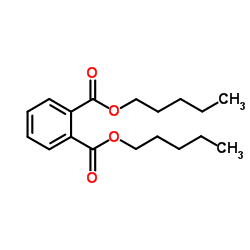Di-n-Amyl phthalate

Di-n-Amyl phthalate structure
|
Common Name | Di-n-Amyl phthalate | ||
|---|---|---|---|---|
| CAS Number | 131-18-0 | Molecular Weight | 306.40 | |
| Density | 1.0±0.1 g/cm3 | Boiling Point | 357.0±10.0 °C at 760 mmHg | |
| Molecular Formula | C18H26O4 | Melting Point | -55ºC | |
| MSDS | Chinese USA | Flash Point | 188.8±8.5 °C | |
| Symbol |


GHS08, GHS09 |
Signal Word | Danger | |
|
Analysis of phthalates in milk and milk products by liquid chromatography coupled to quadrupole Orbitrap high-resolution mass spectrometry.
J. Chromatogr. A. 1362 , 110-8, (2014) A new analytical method was developed and validated for simultaneous analysis of 27 phthalates in milk and milk products. Response surface methodology was employed to optimize a quick, easy, cheap, effective, rugged, and safe (QuEChERS) sample preparation met... |
|
|
Developing structure-activity relationships for the prediction of hepatotoxicity.
Chem. Res. Toxicol. 23 , 1215-22, (2010) Drug-induced liver injury is a major issue of concern and has led to the withdrawal of a significant number of marketed drugs. An understanding of structure-activity relationships (SARs) of chemicals can make a significant contribution to the identification o... |
|
|
A predictive ligand-based Bayesian model for human drug-induced liver injury.
Drug Metab. Dispos. 38 , 2302-8, (2010) Drug-induced liver injury (DILI) is one of the most important reasons for drug development failure at both preapproval and postapproval stages. There has been increased interest in developing predictive in vivo, in vitro, and in silico models to identify comp... |
|
|
Rapid screening and identification of multi-class substances of very high concern in textiles using liquid chromatography-hybrid linear ion trap orbitrap mass spectrometry.
J. Chromatogr. A. 1386 , 22-30, (2015) A new analytical method was established and validated for the analysis of 19 substances of very high concern (SVHCs) in textiles, including phthalic acid esters (PAEs), organotins (OTs), perfluorochemicals (PFCs) and flame retardants (FRs). After ultrasonic e... |
|
|
The ultrastructural effects of di-n-pentyl phthalate on the testis of the mature rat.
Exp. Mol. Pathol. 46(3) , 357-71, (1987) A sequential morphological study has been carried out to examine the ultrastructural effects of di-n-pentyl phthalate (DPP) on the mature rat testis. A single oral dose of 2.2 g DPP/kg body wt was administered, and testes, perfuse-fixed 3-48 hr after dosing, ... |
|
|
Acute adverse effects of the indenopyridine CDB-4022 on the ultrastructure of sertoli cells, spermatocytes, and spermatids in rat testes: comparison to the known sertoli cell toxicant Di-n-pentylphthalate (DPP).
J. Androl. 28(4) , 621-9, (2007) Acute effects of CDB-4022 on testicular ultrastructure were determined. Rats were treated orally with vehicle or a maximally effective single dose of CDB-4022 or Di-n-pentylphthalate (DPP). Preserved testes were processed for transmission electron microscopy.... |
|
|
Accelerated degradation of dipentyl phthalate by Fusarium oxysporum f. sp. pisi cutinase and toxicity evaluation of its degradation products using bioluminescent bacteria.
Curr. Microbiol. 52(5) , 340-4, (2006) The efficiency of two lipolytic enzymes (fungal cutinase and yeast esterase) in the degradation of dipentyl phthalate (DPeP) was investigated. The DPeP degradation rate of fungal cutinase was surprisingly high, i.e., almost 60% of the initial DPeP (500 mg/L) ... |
|
|
Determination of phthalates released from paper packaging materials by solid-phase extraction-high-performance liquid chromatography.
J. Chromatogr. Sci. 52(5) , 383-9, (2014) A solid phase extraction (SPE) high-performance liquid chromatography (HPLC) method was developed for the simultaneous determination of 10 phthalic acid esters (dimethyl phthalate, diethyl phthalate, dipropyl phthalate, benzylbutyl phthalate, diisobutyl phtha... |
|
|
Reproductive toxicology. Di-n-pentylphthalate.
Environ. Health Perspect. 105 Suppl 1 , 255-6, (1997)
|
|
|
The morphological development of di-N-pentyl phthalate induced testicular atrophy in the rat.
J. Pathol. 139(3) , 309-21, (1983) Prepubertal rats treated orally with di-n-pentyl phthalate at 2.2 g/kg body weight were killed at 1, 3, 6 and 24 hr following a single dose, and after 2, 3 and 4 days of repeated daily dosing. At 3 hr Sertoli cells in a proportion of the seminiferous tubules ... |